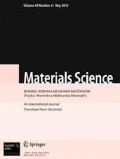We study the mechanism of corrosion cracking of Kh70 steel in a neutral soil electrolyte under the conditions of cathodic protection. We distinguished three areas of potentials in which the processes of corrosion cracking of steel are governed by different mechanisms. Thus, the process of local anodic dissolution proves to be predominant under potentials more positive than – 0.75 V, the mechanism of hydrogen embrittlement is predominant under potentials more negative than – 1.05 V; at the same time, both these mechanisms act within the range of potentials from – 0.75 to – 1.05 V.




Similar content being viewed by others
References
V. I. Khizhnyakov, “On the controlling role of the current density of cathodic protection in the formation of corrosive and stresscorrosion defects on the outer surfaces of gas-oil mains,” Vestn. TGU, 18, Issue 5, 2248–2252 (2013).
M. A. Bashaev, N. P. Glazov, and N. N. Glazov, “Influence of the state of the insulation of pipelines on the rate of their corrosion fracture,” Truboprovod. Transp. (Theor. Prakt.), No. 1, 47–49 (2009).
Y. Maocheng, J. Wang, E. Han, and W. Ke, “Local environment under simulated disbonded coating on steel pipelines in soil solution,” Corr. Sci., 50, No. 5, 1331–1339 (2008).
Z. Y. Liu, X. G. Li, C. W. Du, and Y. F. Cheng, “Local additional potential model for effect of strain rate on SCC of pipeline steel in an acidic soil solution,” Corr. Sci., 51, No. 12, 2863–2871 (2009).
Z. Y. Liu, X. G. Li, C. W. Du, G. L. Zhai, and Y. F. Cheng, “Stress corrosion cracking behavior of Kh70 pipe steel in an acidic soil environment,” Corr. Sci., 50, No. 8, 2251–2257 (2008).
S. Dey, A. K. Mandhyan, S. K. Sondhi, and I. Chattoraj, “Hydrogen entry into pipeline steel under freely corroding conditions in two corroding media,” Corr. Sci., 48, No. 9, 2676–2688 (2006).
Y. F. Cheng, “Fundamentals of hydrogen evolution reaction and its implications on near-neutral pH stress corrosion cracking of pipelines,” Electrochim. Acta, 52, No. 7, 2661–2667 (2007).
Y. F. Cheng and L. Niu, “Mechanism for hydrogen evolution reaction on pipeline steel in near-neutral pH solution,” Electrochem. Comm., 9, No. 4, 558–562 (2007).
S. A. Shipilov and I. L. May, “Structural integrity of aging buried pipelines having cathodic protection,” Eng. Fail. Anal., 13, No. 7, 1159–1176 (2006).
V. A. Voloshyn, O. I. Zvirko, and P. Ya. Sydor, “Influence of the compositions of neutral soil media on the corrosion cracking of pipe steel,” Fiz.-Khim. Mekh. Mater., 50, No. 4, 44–47 (2015); English translation: Mater. Sci., 50, No. 5, 671–675 (2015).
J. Capelle, J. Gilgert, I. Dmytrakh, and G. Pluvinage, “The effect of hydrogen concentration on fracture of pipeline steels in presence of a notch,” Eng. Fract. Mech., 78(2), 364–373 (2011).
G. Van Boven, W. Chen, and R. Rogge, “The role of residual stress in neutral pH stress corrosion cracking of pipeline steels. Part. II: crack dormancy,” Acta Mater., 55, No. 1, 43–53 (2007).
X. Tang and Y. F. Cheng, “Micro-electrochemical characterization of the effect of applied stress on local anodic dissolution behavior of pipeline steel under near-neutral pH condition,” Electrochim. Acta, 54, No. 1, 1499–1505 (2009).
Z. Y. Liu, X. G. Li, and Y. F. Cheng, “Mechanistic aspect of near-neutral pH stress corrosion cracking of pipelines under cathodic polarization,” Corr. Sci., 55, 54–60 (2012).
L. I. Nyrkova, S. O. Osadchuk, A. O. Rybakov, and S. L. Mel’nychuk, “Methodical approach and a criterion for the evaluation of the susceptibility of pipe steel to corrosion cracking,” Fiz.-Khim. Mekh. Mater., 55, No. 5, 14–20 (2019); English translation: Mater. Sci., 55, No. 5, 625–632 (2020).
L. I. Nyrkova, S. L. Mel’nychuk, S. O. Osadchuk, and A. O. Rybakov, “Corrosion cracking of Kh70 pipe steel for potentials close to the maximum protective potential,” Fiz.-Khim. Mekh. Mater., 54, No. 4, 110–115 (2018); English translation: Mater. Sci., 54, No. 4, 567–572 (2019).
Author information
Authors and Affiliations
Corresponding author
Additional information
Translated from Fizyko-Khimichna Mekhanika Materialiv, Vol. 56, No. 2, pp. 124–129, March–April, 2020.
Rights and permissions
About this article
Cite this article
Nyrkova, L.I. Corrosion Cracking of Kh70 Pipe Steel under the Conditions of Cathodic Protection. Mater Sci 56, 273–278 (2020). https://doi.org/10.1007/s11003-020-00425-x
Received:
Published:
Issue Date:
DOI: https://doi.org/10.1007/s11003-020-00425-x




